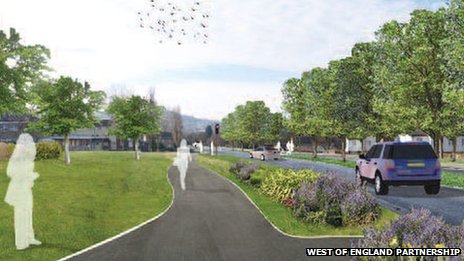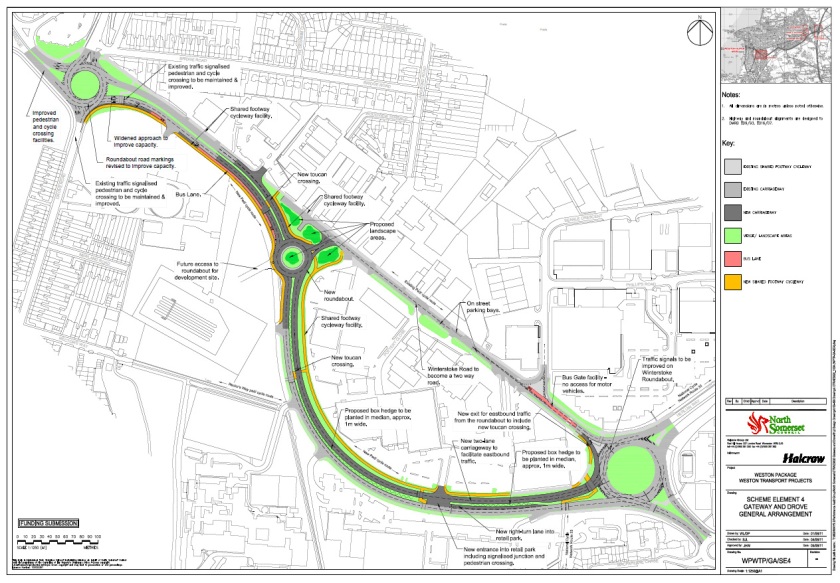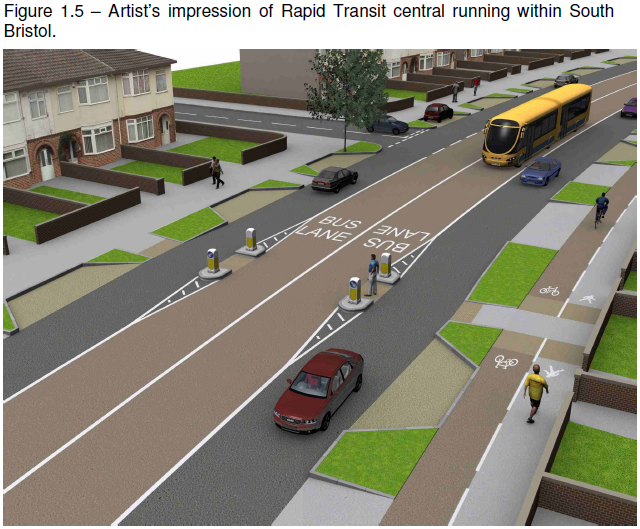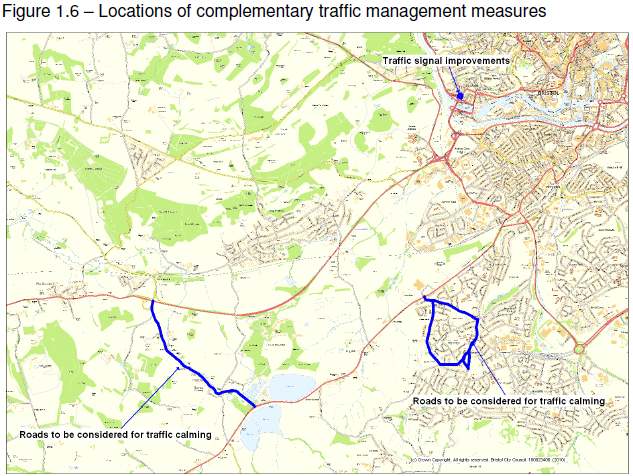Continuing from last month…
It should be noted, in case any confusion remains — and I’ve seen plenty — that despite the superficial similarities, “shared use” and “shared space” are quite different things. “Shared space” is a road with a less than the traditional amount of delineation between pedestrians, cyclists and motor vehicles, as at Exhibition Road. “Shared use” is an off carriageway or away from road facility — a pavement or path — shared between cyclists and pedestrians.
I noticed a slightly different kind of “shared space”/”shared use” conflation when skimming through the Living Heart campaign’s reply to the Bristol Central Area Action Plan. Obviously the Living Heart folk know the difference between them — one of them being an academic expert on the misuse of shared space — but they do suggest that the enthusiasm for shared use in local authority highways departments and in documents like LTN 2/08 is related to the ideology behind shared space:
The [shared space] ideology discussed in Section 4.2 has also led to a strange belief in the UK that compelling pedestrians and cyclists to share space is better than providing separate space for each (as is now normal practice in larger cities in the Netherlands and Denmark). In circumstances where space is constrained (in some cases unnecessarily, on paths which are too narrow) or flows of pedestrians (e.g. Broadmead) or cyclists (Bristol to Bath cycle path) are high, this is causing significant conflicts.
I don’t believe this. The evangelism for the extreme Exhibition Road variety of shared space is inspired by a libertarian ideology which makes the claim, against all evidence and experience, that if we remove all regulation and restriction from road users then the optimal order will naturally arise through lots of little interactions and subtle negotiations. Obviously order does form from the chaos of this form of shared space, but it’s an order in which motorists rule and pedestrians huddle at the edges out of the way.
Shared use, on the other hand, is cheap and easy. I’ve been looking at the history of it and I don’t think the reason, logic or ideology behind it is really much more complicated than that.
There are two types of shared use, with slightly different histories: pavements, and away-from-road paths. The big driving force behind away-from-road paths has been Sustrans. They tend to build ~3 metre wide shared paths — most of their surfaced rail trails are of this design — their reasoning being that “shared” is “flexible”: when numbers of one type of user or the other are high, and the other low, you’re not trying to deny the crowds use of a perfectly good empty bit of path. Sustrans correctly reasons that it is best for them to build ~3 metre shared paths, rather than trying to segregate users into two pieces of ~1.5 metre path separated with a white line as is sometimes the case, and as Sustrans tried on the Bristol Railway Path for a while. But only because Sustrans is an overstretched charity trying to get the most for their money, and who therefore don’t want to buy asphalt for more than 3 metre wide paths. Their choice is therefore shared or segregated 3 metre paths, and shared is the best of those options.
 (cc) Edinburgh Cycle Chic, by-nc-sa
(cc) Edinburgh Cycle Chic, by-nc-saBetter still is a 5 metre segregated path, like the route through Edinburgh University and the Meadows, but Sustrans are going for the cheap option and most councils have copied them.
Shared pavements have a slightly different history. So far as I can see, they are an invention of the early 1980s, with authority to construct/convert what it rather optimistically calls “cycle tracks” being introduced by the Highways Act 1980 (Cycling England had a document explaining it (PDF)). The 1980 Highways Act was a little before my time, so I tried to look up the original intention of the “cycle tracks” through the parliamentary debates. We know, of course, that Thatcher’s was an extreme pro-car and pro-road expansion government, famous for The Great Car Economy and Roads For Prosperity. My guess was that, if the government of the time even noticed that cycling existed, it probably saw it as a form of transport in terminal decline — something backward and even irresponsible. I was expecting to find that the purpose of shared pavements was not to enable or encourage the irresponsible act of cycling, but that they were a quick and cheap road safety measure intended to get bicycle users out of harms way for as long as it took the poor things to save up and buy a car of their own.
It was an impression partly supported by the BMA’s 1992 book on cycling, but I haven’t found much in which the Thatcher government puts its hostility to cycling into words — though it did slip out in this astonishing 1989 exchange in which Transport Secretary Paul Channon tells an Oxford MP that enabling cycling would be a bad thing for Oxford, given that the town has a car factory.
Rather, it seems that the government of the early 1980s had much the same attitude to cycling as the government now, and did much the same thing as the Labour government of the late 1970s, the Major government in the mid 1990s and the Blair government at the turn of the century. They saw that “cycling is booming“, paid lip service to it, published a statement of policy and then failed to devote anything near adequate resources to implementing the policy, relied almost entirely on local authorities to implement the policy and failed to ensure that the resources that had been allocated to LAs were actually going to be spent on interventions that work, until eventually everybody simply forgot that the policy had ever been declared. As the British Medical Journal put it, “The Government should stop its delaying tactics, with its stream of vapid consultative documents, and act to ensure that its citizens can travel safely and freely without hindrance by others.” To be fair, they did at least try to focus what little effort and funding they did devote to cycling specifically into better routes.
So the government and our representatives were probably no more and no less hostile to cycling than today’s. Perhaps, then, shared pavements weren’t meant as a simple get-them-out-of-the-way measure?
The 1980 Highways Act was very wide ranging — cycling was a tiny little bit, Section 65 of 345, and so cycling was only a tiny little bit of a debate and discussion. Part of that debate actually took place under the predecessor Labour government, in 1978, and the comments of under-secretary for Transport, John Horam, illustrate how that government was imagining the cycle tracks, mocking Dennis Skinner for suggesting that we should need or want to spend money on anything more than a white line on a footway:
Mr John Horam (Labour, Gateshead West)
On the question of cycle tracks and the clarity of the legislation, I again give the commitment that we shall make perfectly plain what is the law on this matter. It is within the powers of local authorities simply to draw a white line on a footway and turn at least part of it into a cycle track. We shall spell out all these details in the technical note.
Mr Dennis Skinner (Labour, Bolsover)
Worse than skateboarding.
Mr John Horam
I fear that we may be getting some dissension from my hon. Friend the Member for Bolsover, but I do not think that I shall draw him into the debate, because I know that he is strongly in support of this broad principle.
Mr Dennis Skinner
I support these principles, as one who owns a Raleigh with five gears. … I am intrigued about the business of having a white line down a footpath, with cyclists on one side. I can visualise myself travelling at 35 mph—when I am at my best—and a poor old lady walking down the other side of the white line. It seems to me that we need to look back a bit. Before the war, when we had other job creation schemes in hand not far from Clay Cross, the Government of the day—they were not of the present type, though I suppose that they were not all that much different—put forward a scheme for a cycle track between Clay Cross and Chesterfield, which stood on its own. If we are to launch out, I, as one who is not afraid to talk about public expenditure and mopping up some of the unemployed, am happy about advancing the case for proper cycle tracks at the side of the pavement, or somewhat removed from it, with none of this white line nonsense.
Mr John Horam
I take it that Clay Cross will be building large, expensive kerbs between cycle tracks and pedestrian facilities when it gets round to this, as no doubt it will. Everything happens in Clay Cross. No doubt the council will notice this new legislation and be eager to implement it at the first opportunity, so that the hon. Member for Acton and my hon. Friend can use the cycle track at Clay Cross when it comes into being.
So, again, the point of shared pavements was that they were cheap and easy — features that were especially important in 1978. The chair of the All Party Friends of Cycling Group agreed that cyclists were cheap and easy.
The new Conservative government didn’t debate cycling again before the Highways Bill became the Highways Act, but it did come up again in 1984 with the Cycle Tracks Act, which sought to simplify the bureaucracy for converting public footpaths to shared paths. It was primarily intended for urban alleyways, passageways and paths through parks and allotments — things like this and this. The story of the Act perhaps illustrates the attitudes and intentions for shared paths and pavements.
The Cycle Tracks Bill was introduced as a private member’s bill by the newly elected Conservative MP Barrow and Furness, Cecil Franks, though it was picked up and backed by the government. Franks, a local council man who was probably surprised to find himself in parliament representing a traditionally Labour seat, explained his motivation for introducing the bill: as a local councillor he had sincerely wanted to introduce more away-from-roads cycle routes, but the bureaucracy of seeking permission to “close” the footpath and then planning permission to “construct” the new cycle track — when in fact no physical works at all would be required — had been too great.
The Bill received cross-party support, and the stated intentions for all who spoke in the debates was to enable and encourage cycling. As Simon Hughes (Liberal, Bermondsey) said:
Liberal Members welcome the Bill. I feel confident, as I think do all hon. Members who have participated in the debate, that one result will be a reduction in the number of accidents, many of which can debilitate people and reduce their mobility for life, which are occasioned at present by cycle users, pedestrians and motorised transport users taking the same routes and getting in each other’s way. It is my belief that it should also result in an increased use of the bicycle throughout the country…
…His Bill is greatly welcomed by the Liberal party, as it is by all parties and by a large number of present cyclists and those who, as a result of it, will become cyclists. It is to the advantage of all.
If they thought that cycling was a means of transport in terminal decline that should be cleared out of the way for as long as it takes to die out, they certainly didn’t say so. Quite the opposite: starting from about 1979, it has been obligatory to start such speeches with “cycling has been booming in recent years…“.
There were only a couple of critical remarks. Colin Moynihan (Conservative, Lewisham East) was critical of the narrow scope of the Bill, mentioning lack of design standards — and the lack of understanding from MPs of the need for them — for the shared pavements which had been introduced previously:
These questions are central to the consultation proposals behind the Bill and the importance that it gives to the safety of cyclists. The difficulties involved have in many ways been underestimated in the debate. The Cyclists Touring Club document on the Bill states that in the past cycle tracks have been extremely dangerous as well as unsatisfactory in other ways. It states: “There is neither priority nor protection for the cyclist at junctions from other traffic turning across his path or leaving minor roads, work entrances and private drives across the track. The majority of motorists, even if they notice the existence of the tracks, assume that they have priority over cyclists using them. It is usually difficult for a cyclist approaching a junction to ascertain the intentions of following motorists and inconvenient for a cyclist to stop and give way at every junction, no matter how minor, in order to be assured of no conflict. Queues of vehicles waiting to enter the major road from a minor one also invariably block the cycle track.” I have discovered that from my own experience. “Indeed, it is seldom possible to leave a cycle track sufficiently in advance of a junction in order to safely execute a right turn.” The greatest danger to cyclists certainly occurs at major junctions, especially roundabouts, where it is crucial that the highway code be observed. Other examples are bottlenecks such as bridges. Yet at these points cycle tracks often cease to exist. My hon. Friend the Member for St. Albans (Mr. Lilley) spoke of the difficulty of matching a completed cycle track with a similar stretch on the other side of the road. Cycle tracks may suddenly cease to exist, pitching the cyclist into a maelstrom of traffic at the most dangerous places. The Bill seeks to tackle those problems….
…Furthermore, the Cyclists Touring Club states: “Cycle tracks are frequently illegally obstructed and enforcement of parking restrictions has a low priority with the police. Defective vehicles are often moved on to a cycle track in order to clear the main carriageway even by the police themselves.” The maintenance of cycle tracks is given a low priority by local authorities. I hope that the bill will encourage local authorities to become more actively involved in the development of cycle tracks, and that there will be a move to greater local involvement in the development of cycle tracks….
…The Bill will achieve many of the CTC’s aims, including the banning of mopeds from cycle tracks and the banning of parking on cycle tracks, which has concerned many people for a long time. It will now be an offence to drive or park partly or wholly on a cycle track….
…The most important part of the process is the construction of the cycle track. There is no point in having cycle tracks that are a mass of potholes and inefficiently built, as they might serve only to add to the risks faced by cyclists.
and criticism of shared use from Gerry Bermingham (Labour, St Helens South) — albeit only from the “danger and discomfort for pedestrians” point of view and not also from the “not attractive for cycling” point of view:
As it is proposed that there should in some cases be tracks containing cyclists and pedestrians, I have reservations about the Bill. On my way to the House on Wednesday I was nearly mown down by cyclists coming up on the pavement behind me. That reminded me of the dangers of intermingling pedestrians and cyclists. There is much point, therefore, in the argument of the Royal National Institute for the Blind. If we allow the two to be near each other, there must be a segregating feature, not only for the blind but especially for small children using the footpaths.
It has been suggested that there might be a curb to sector the area. In my view, that would be the minimum solution, and I should not be happy simply with white lines, which are meaningless to the blind and are ignored to a large extent by young children who have not yet acquired the safety techniques, so to speak, of being with traffic.
But otherwise, members from all parties agreed that shared paths and pavements would be a good cheap and easy way to encourage and enable cycling, and didn’t see any need to bother themselves thinking about standards of design and maintenance.
And I don’t think that local authorities today think about shared use any differently: I don’t think there is any widespread idea that pedestrians and cyclists should be mixed — that it is an inherently good thing. Councils think of shared use, if they spend any time thinking about it at all, exactly as the MPs of the early 1980s did: it’s cheap and easy.
But even “cheap” is expensive when it’s money wasted on things that don’t work. So, while the intentions of thirty years ago might have been all good, the same can’t be said now that we have thirty years of experience with unattractive and ineffective shared pavements. If MPs today are serious about enabling and encouraging cycling they must retire these crap facilities in favour of infrastructure that actually works.


















